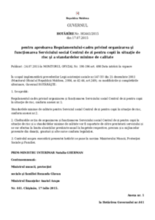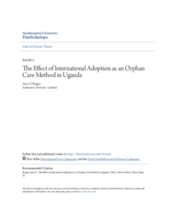Demographic Data
|
Sources: World Bank, UNICEF, UNDP HDR 2015, DHS 2011 |
Displaying 11691 - 11700 of 14389
In this blog piece from the Huffington Post, Mirah Riben describes the phenomenon of “re-homing” in which many adoptive parents in the United States, typically of internationally adopted children, give up those adopted children after a period of time, often times to people who are not properly vetted and who may harm the children.
This edited volume introduces the complexity of intercountry adoption and gives voice to the many sides of the intercountry adoption debate – for, against, and the ranges in between.
This quantitative study of 575 South African children compared their resilience in terms of individual, family and community protective factors across seven sites, including child and youth care centres, schools in poor communities and schools in middle-class suburban communities.
Using panel data from the Philippines' Family Income and Expenditure Survey (FIES), this paper also looks into how such dynamics affects children's welfare. Meanwhile, to complement the profile on child poverty, this paper scrutinizes how the government has faired so far in addressing poverty via its biggest social protection programme, the Pantawid Pamilyang Pilipino Program (4Ps). The brief review also touches on a variant of the Pantawid Pamilya that caters to street families, particularly its design and targeting strategy, and other Department of Social Welfare and Development programmes involving the welfare of children.
As a network, we aim to achieve more by working together for children than by working in isolation.
For the first years of CRANE’s life, the network strove to be the strongest and most effective Christian
network and to see Christians working together in strategic partnerships towards transformational
change for children. By the 10th anniversary, the network had established that platform. Therefore we
are now looking to make our unique contribution much clearer and much more challenging.
Este trabalho teve por objectivo analisar e compreender a magnitude, tendências, determinantes e impactos do casamento prematuro e da gravidez precoce, com o propósito de obter informações para a concepção de uma política nacional.
În scopul implementării prevederilor Legii asistenţei sociale nr.547-XV din 25 decembrie 2003 (Monitorul Oficial al Republicii Moldova, 2004, nr.42-44, art.249), cu modificările și completările ulterioare, Guvernul HOTĂRĂŞTE:
This booklet has been designed to help local authorities, schools and their partners work together to ensure they can provide every child, including looked after children, with the kind of positive learning experience which is the foundation for future success.
This literature review addresses how international adoption affects Uganda’s orphan care methods from both micro and macro perspectives.
This report intends to share the status of the child care homes (CCHs) in Nepal - facts and figures, problems, financial supports and progress.







